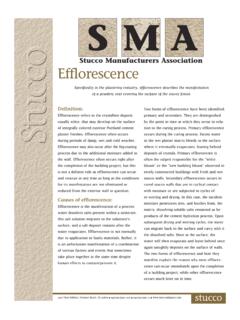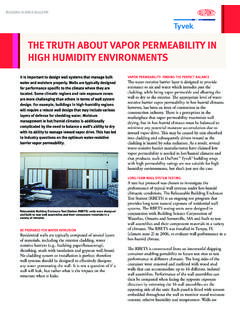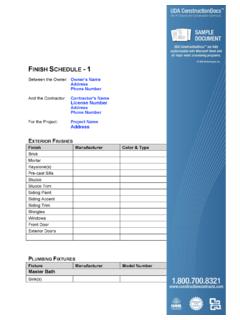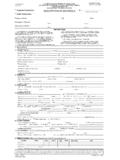Transcription of TECHNICAL BULLETIN 4 Crack Policy - Educating the …
1 Crack PolicyTECHNICAL BULLETIN 4 stucco is widely used all over the world as anexterior cladding because of its aesthetic appeal,durability, fire resistance, design flexibility, lowcost, and ease of maintenance. stucco is by nature hard and strong, but it is relatively thinand brittle and will Crack when subjected tostresses that exceed its tensile are two fundamental types of stresses that cause stucco cracks internal and external. Internal stresses are due to the natural curingand drying process of stucco . stucco shrinks asit hardens and gains strength. This shrinkage,when restrained, may create hairline stresses are due to the transfer of out-side forces into the stucco assembly.
2 Commonexamples are at the corners of windows anddoors. These stresses can cause movementwithin the stucco , which can result in widercracks than internally generated cracks. The following are common, but not exclusive,sources of external stresses that may lead to cracking: Movement of framing and sheathing: Lumber and wood-based sheathing are sub-jected to dimensional variations associated withthe loss or gain of moisture. Cold formed metalframing is subjected to dimensional variationsdue to thermal expansion and contraction. Improperly applied wood-based sheathing:Wood-based sheathing not properly gapped canswell and put pressure on the stucco .
3 Soil movement:Seismic events, settlement,and expansion of soil under the building cancause movement of the foundation. Loads on building:Live loads ( traffic, furniture, and occupants) and dead loads ( roof tile). Wind:Wind can place pressure on stucco wall panels. Construction process:Today s constructionjobsites subject stucco to stresses from workers,vehicles, vibration, and other forms of abuse. Toensure full satisfaction with the stucco assembly,reasonable expectations should be establishedwith respect to cracking prior to selection of thestucco assembly and plastering contractor. Thebuilding owner should expect hairline cracksand diagonal cracks emanating from the cornersof windows and doors.
4 By following industry best practices, the poten-tial for cracking can be reduced (but not elimi-nated). Some of these best practices apply to thedesigner of the building, and others are underthe builder s or plastering contractor s include: Incorporate control joints in accordance withASTM C 1063 guidelines. Wherever dissimilarmaterials meet and every 100 150 square feet,control joints should be used to separate thepanels. The moisture barrier should be installedcontinuously behind the joint. Heavier textures can make normal crackingless conspicuous. Properly installed moisture barriers, integratedwith flashings, are critical to minimize moisturepenetration.
5 The builder should ensure that framing isstraight and true and will not subject the stuccoassembly to undue stress or excessive thicknessvariation. Use good quality aggregate, stucco , lath, moisture barrier, and trim materials per ASSOCIATIONSARIZONA ASSOCIATION OF WALLS & PLASTERING & LATHING CEMENT ASSOCIATION PLASTERING INSTITUTEFOR LATH & & PLASTER CONTRACTORS ASSOCIATION OF SAN FRANCISCO/SAN & PLASTERING WALL & CONTRACTORS ASSOCIATION OF SOUTHERN CEMENT PLASTERERS OF VALLEY BUREAUFOR LATH & MANUFACTURERS SERVICES INFORMATION CENTRAL WALL, CEILING & PLASTER COUNCIL, 2402 VISTA NOBLEZA, NEWPORT BEACH, CA 92660 PHONE FAX1/2 Install wood-based sheathing according toAPA industry guidelines.
6 Load roofs prior to application of scratch andbrown coats. Install drywall prior to application of finishcoat. Ensure proper curing per manufacturer orcode requirements. Builders should test soils and ensure propercompaction/fill to minimize foundation movement. Keep framing dry, properly seal junctions of dissimilar materials ( common joints, windows, doors, vents, pipes).When cracks occur, the building owner, builder,plastering contractor, and any subject matter experts involved will make a joint decision onthe proper course of action. Each Crack shouldbe analyzed on a Crack -by- Crack basis, to deter-mine probable cause, whether or not repair is required, and if so, how repair should be accomplished.
7 The evaluation should considerthe potential for water penetration, aesthetics,whether the Crack is still active, and all otherappropriate considerations. This analysis shouldalso determine the cost of repairs and who isgoing to absorb the expense. In general, allcracks should be fixed if they are wide enoughto permit water to enter through the exteriorcladding system. Industry practice is to repairany cracks that exceed 1/16 in width, althoughjobsite circumstances may suggest deviationsfrom this normal simplest Crack repair method is to use thesame material as the color coat. Once the crackhas been filled, fogcoat may be used to even out the color around the repaired area.
8 Othercommon repair methods may be better suited to active cracks. Consult the stucco finish manufacturer or contractor for recommendedrepair 2008 Supersedes SMA TECHNICAL BULLETIN 4: Crack PolicyCRACK Policy TECHNICAL BULLETIN 42/2








